Next Bundle
Can Next Company Continue Its Retail Reign?
Next plc, a British retail giant, has consistently defied expectations in a rapidly evolving market. From its origins in 1982, Next has transformed, embracing online sales and strategic acquisitions. Its adaptability is evident in its impressive financial results and forward-thinking approach to business development.
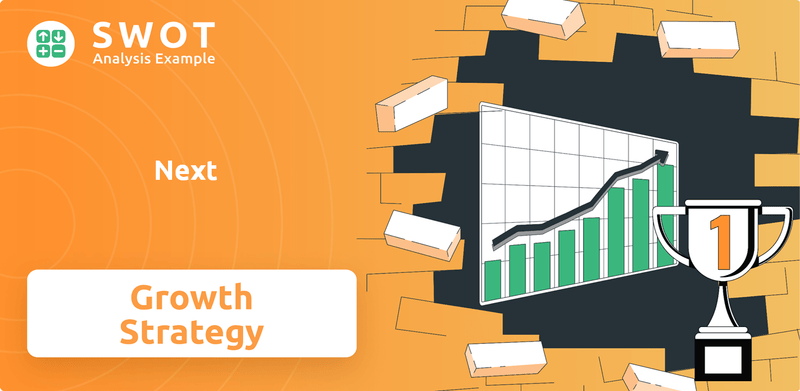
Next's Next SWOT Analysis reveals key insights into its growth strategy and future prospects. The company's ability to navigate challenges and capitalize on opportunities is critical. This analysis will delve into Next's strategic planning, market analysis, and long-term goals, providing a comprehensive view of its competitive advantages and potential for future growth in the e-commerce market.
How Is Next Expanding Its Reach?
Next plc is actively pursuing several expansion initiatives to fuel its future growth. These initiatives focus on both geographical expansion and diversification of its brand portfolio. The company aims to strengthen its brand presence globally while strategically acquiring and integrating other brands.
A key element of this strategy involves growing the brand's presence overseas. The company is also focused on expanding its business through mergers and acquisitions to broaden its offerings and diversify revenue streams. These efforts are supported by investments in its online platform and the development of services for third-party brands.
This approach is designed to capitalize on existing market opportunities and tap into new ones, ensuring sustainable growth. The company is also looking to enhance its online platform and expand services for its partners.
Online overseas sales have shown significant growth, increasing by 31.4% in Q4 2024. This contributed to a 23.9% increase for the year ending December 2024. The company is targeting a more moderate growth of 14% for online overseas sales in the fiscal year 2025-26.
Approximately 90% of the company's overseas business currently originates from Europe and the Middle East. These regions are efficiently serviced from the UK. The company sees substantial untapped potential in these markets and is also increasing its presence in new territories.
The company has strategically expanded through mergers and acquisitions, integrating third-party brands onto its 'Total Platform.' This includes increasing its equity stake in Reiss and acquiring FatFace and the intellectual property of Cath Kidston. These acquisitions are aimed at diversifying revenue streams.
The Total Platform business, which provides online operations and fulfillment services, is a rapidly growing segment. It accounted for 0.9% of group sales in FY2023. The company launched three new Total Platform clients in the year ending January 2024, bringing the total to seven.
The company's expansion strategy includes both organic growth and strategic acquisitions. The focus on overseas markets and the development of the Total Platform are key elements of its growth strategy. This approach is supported by the company's financial performance and market analysis.
- The company is investing in its online platform and services for third-party brands.
- The company is also opening and closing a small number of stores, with total expenditure on new space expected to be £22 million in the 2024 financial year.
- The company's strategy includes strengthening the brand overseas and diversifying its brand portfolio.
- The company is focused on the future prospects of its business through strategic planning and market analysis. To learn more about the company's history, check out this Brief History of Next.
Next SWOT Analysis
- Complete SWOT Breakdown
- Fully Customizable
- Editable in Excel & Word
- Professional Formatting
- Investor-Ready Format
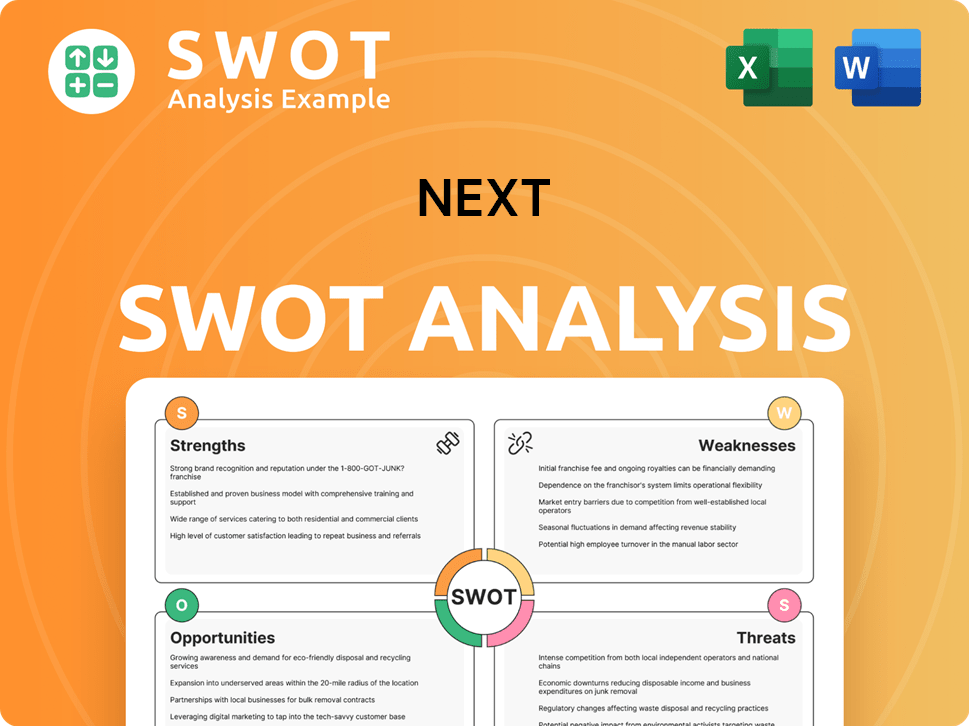
How Does Next Invest in Innovation?
The innovation and technology strategy of Next plc, a company focused on retail, is primarily geared towards driving sustained growth through its 'Total Platform' business model and ongoing digital transformation efforts. This approach is pivotal in adapting to evolving consumer needs and preferences in the retail sector. The company's strategic moves are aligned with the dynamic shifts in the market, ensuring it remains competitive and responsive to customer demands.
Next's strategy also involves the development of new brands and licenses, along with the acquisition of existing third-party brands. These initiatives enable the company to leverage its specialist sourcing and technical skills, combined with established brand heritage. The focus on digital marketing, website enhancements, and improved delivery services reflects a commitment to meeting the changing expectations of consumers.
The company's approach to innovation is also highlighted by its ESG initiatives, which include multi-year projects focused on carbon reduction, responsible sourcing, waste reduction, and recycling. This showcases a broader commitment to innovation that extends beyond retail operations, aligning with the increasing importance of sustainability in consumer preferences and market trends.
The 'Total Platform' is a key element of Next's growth strategy. This platform allows Next to host third-party brands on its website and manage fulfillment from its warehouses. This model accounted for 0.9% of group sales in FY2023.
In the year ending January 2024, Next expanded its Total Platform client base by launching three new clients: JoJo Maman Bébé, Joules, and MADE. This increased the total number of clients to seven, demonstrating a focus on business development.
Next plans to enhance the Total Platform further by improving and broadening services for its clients. This includes advanced website content management tools, a more sophisticated promotions engine, and a comprehensive wholesale system.
The company is actively involved in developing new brands and acquiring existing ones. This includes brands like 'Love & Roses,' Cath Kidston, and MADE, leveraging Next's sourcing and technical skills.
Next emphasizes digital marketing and improvements to its website to drive growth. This includes enhancing the speed and accuracy of its delivery services and contact center assistance.
The company's ESG highlights for 2024/25 indicate ongoing multi-year ESG projects related to carbon reduction, responsible sourcing, reducing packaging and waste, and recycling, demonstrating a broader commitment to innovation beyond just retail operations.
Next's strategic planning involves a multi-faceted approach to innovation and technology. This includes leveraging the 'Total Platform' for business development and enhancing customer experiences through digital marketing and improved services. For more details on their target market, see Target Market of Next.
- Total Platform: Expanding the platform to include more brands and improve services.
- Digital Marketing: Enhancing online presence and customer engagement.
- Delivery and Customer Service: Improving speed, accuracy, and support.
- ESG Initiatives: Focusing on sustainability through various projects.
Next PESTLE Analysis
- Covers All 6 PESTLE Categories
- No Research Needed – Save Hours of Work
- Built by Experts, Trusted by Consultants
- Instant Download, Ready to Use
- 100% Editable, Fully Customizable
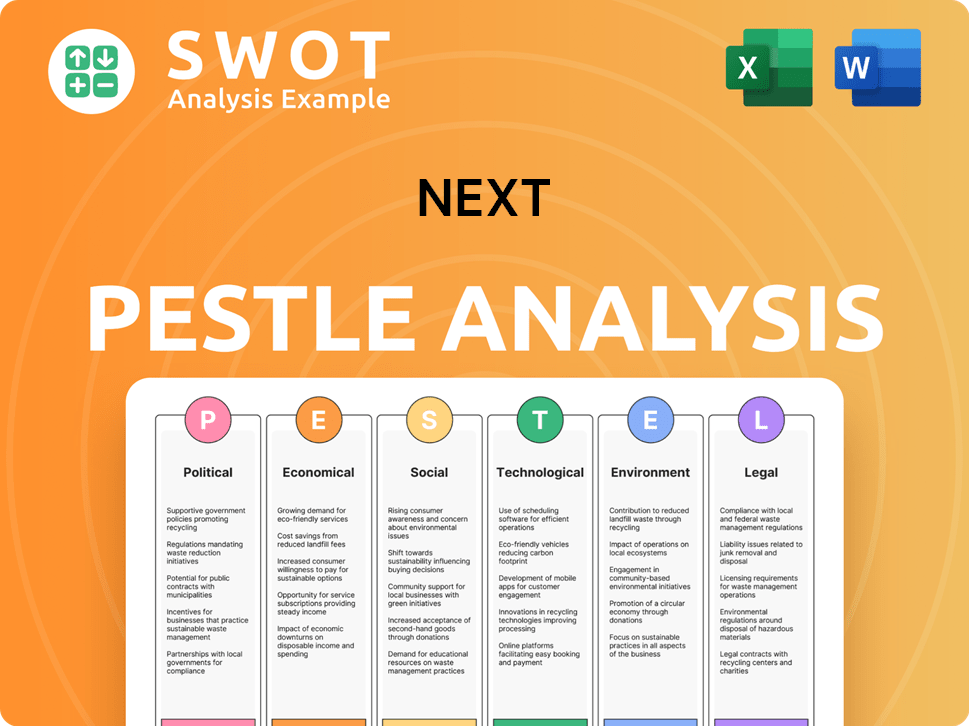
What Is Next’s Growth Forecast?
The financial outlook for Next plc indicates continued expansion, although the pace of growth is expected to moderate in some areas. For the fiscal year 2024/25, the company anticipates full-price sales reaching £5.05 billion, marking a 5.5% increase from the previous year. This growth is supported by strategic planning and effective business development initiatives.
Total Group sales, encompassing markdown, subsidiaries, and investments, are projected to reach £6.6 billion, up from £6.5 billion in prior guidance. The company's focus on strategic planning and market analysis contributes to its ability to forecast and manage these financial targets. This includes a detailed understanding of the Competitors Landscape of Next.
The Group profit before tax for 2024/25 is forecast at £1,010 million, reflecting a 10.0% increase year-over-year. Pre-tax Earnings Per Share (EPS) are expected to increase by 11.4%. These figures highlight the company's strong financial performance and its ability to generate profits, which is essential for future prospects and sustained growth.
Full-price sales are projected at £5.05 billion, a 5.5% increase. Total Group sales are expected to reach £6.6 billion. These figures show the company's growth strategy in action, focusing on both core and expanded sales channels.
Group profit before tax is forecast at £1,010 million, a 10.0% increase. Pre-tax EPS is expected to increase by 11.4%, demonstrating strong financial health. These numbers are key indicators of the company's future prospects.
Full-price sales are expected to reach £5.22 billion, a 3.5% increase. Total Group sales are projected to grow by 3.2% year-over-year to £6.50 billion. This reflects a continued, though slightly moderated, growth trajectory.
Group profit before tax is projected to rise by 3.6% to £1,046 million. Pre-tax EPS is expected to increase by 6.7% to 900.2 pence. Post-tax EPS is expected to be 676.0 pence, up 6.4%.
Next's gross profit margin is 43.5% for the latest twelve months. The company plans to retain £75 million of surplus cash for potential bond repayment in August 2025. Net debt is expected to close at around £625 million, down from £700 million the previous year.
- Share buybacks for the year are expected to total £326 million, reducing net shares by 2.8%.
- The ordinary dividend yield is expected to be 2.8%.
- The financial policy focuses on shareholder value through dividends and buybacks.
- These strategies are crucial for Next Company's long-term goals.
Next Business Model Canvas
- Complete 9-Block Business Model Canvas
- Effortlessly Communicate Your Business Strategy
- Investor-Ready BMC Format
- 100% Editable and Customizable
- Clear and Structured Layout
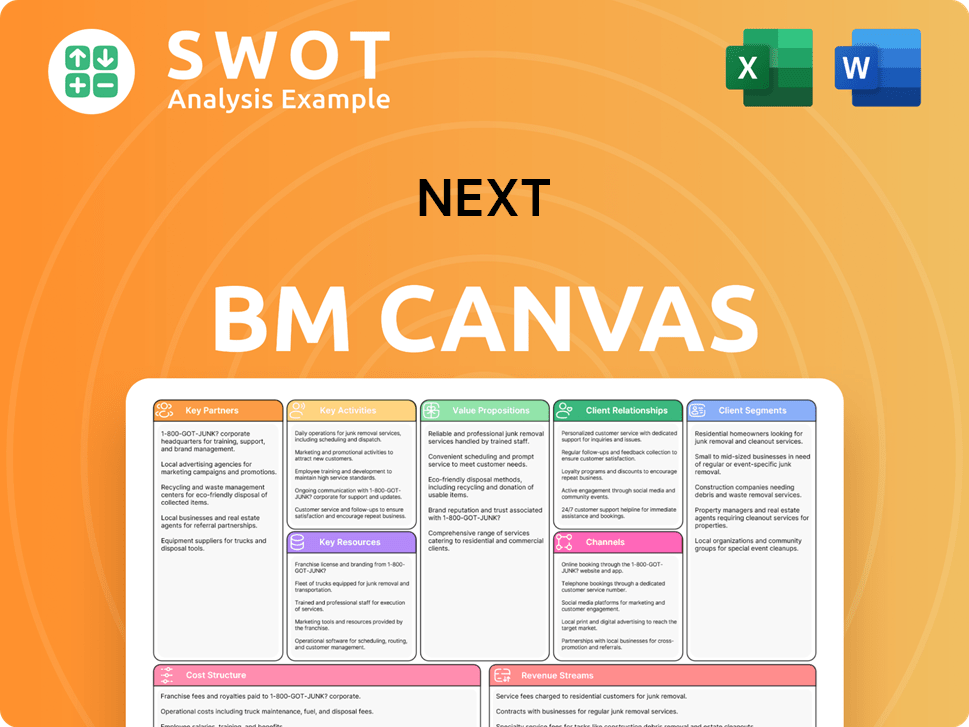
What Risks Could Slow Next’s Growth?
The pursuit of a robust Growth strategy by Next plc is intertwined with navigating several potential risks and obstacles. The company's strategic outlook must account for market dynamics, regulatory changes, and technological disruptions. These factors could significantly impact the Future prospects of the company.
Market competition and evolving consumer preferences present ongoing challenges, particularly in the retail sector. Furthermore, regulatory changes within financial services, where Next operates credit and insurance offerings, could necessitate adjustments to its operational practices. The company's ability to adapt to these and other external pressures will be crucial for sustaining its growth.
Next's Growth strategy faces several key challenges. The retail sector is highly competitive, and consumer preferences can shift rapidly. The decline of high street sales, with a 2.1% decrease in the first half of 2024, highlights the need for continued adaptation.
The retail sector is highly competitive, with consumer preferences constantly evolving. Missteps in product offerings could be costly for the Next Company. Adapting to these changes is essential for maintaining market share and driving Business development.
The decline of brick-and-mortar sales is a concern. Sales softened by 2.1% in the first half of 2024. While the company has a strong online presence, addressing the challenges of physical retail is important.
Regulatory changes, particularly within financial services, pose risks. The Financial Conduct Authority (FCA) is pursuing initiatives, with policy statements expected in 2025. The Treasury is also introducing legislation in 2025 that could affect the company's sustainability reporting.
Supply chain vulnerabilities, although not explicitly detailed, are an inherent risk. However, the company has shown an ability to manage such challenges. For example, adjusting bookings to account for extended transit times and higher freight costs due to Red Sea attacks in early 2024.
Technological disruption is a constant threat in the evolving retail landscape. The need for continuous investment in digital transformation, automation, and cutting-edge technologies like AI and IoT, could present challenges. This requires careful Strategic planning.
Internal resource constraints, particularly related to workforce practices and pay, have also garnered scrutiny. Investors are increasingly seeking transparency regarding workforce management, including retention and productivity. This includes the rise of the National Living Wage to £12.21 from April 2025.
Next addresses these risks through strategies like product and geographical diversification. The company leverages its 'Total Platform' to outsource online operations for third-party brands. The Board oversees risk management, and the Audit Committee monitors ESG progress.
The company must adapt to regulatory changes, particularly in financial services. The FCA's initiatives and the Treasury's legislation will impact operations. Compliance requires ongoing monitoring and adjustments to ensure adherence to new standards.
The company must invest in digital transformation and automation. Keeping pace with technological advancements is crucial. This includes incorporating AI and IoT to enhance operations and customer experiences, which is a key part of the Market analysis.
Next needs to address workforce-related risks and opportunities. Transparency regarding workforce management, retention, and productivity is vital. The increase in the National Living Wage to £12.21 from April 2025 will affect labor costs.
For a more in-depth look at Next's Growth strategy and its financial performance, consider reading an article about Next Company's financial performance analysis.
Next Porter's Five Forces Analysis
- Covers All 5 Competitive Forces in Detail
- Structured for Consultants, Students, and Founders
- 100% Editable in Microsoft Word & Excel
- Instant Digital Download – Use Immediately
- Compatible with Mac & PC – Fully Unlocked
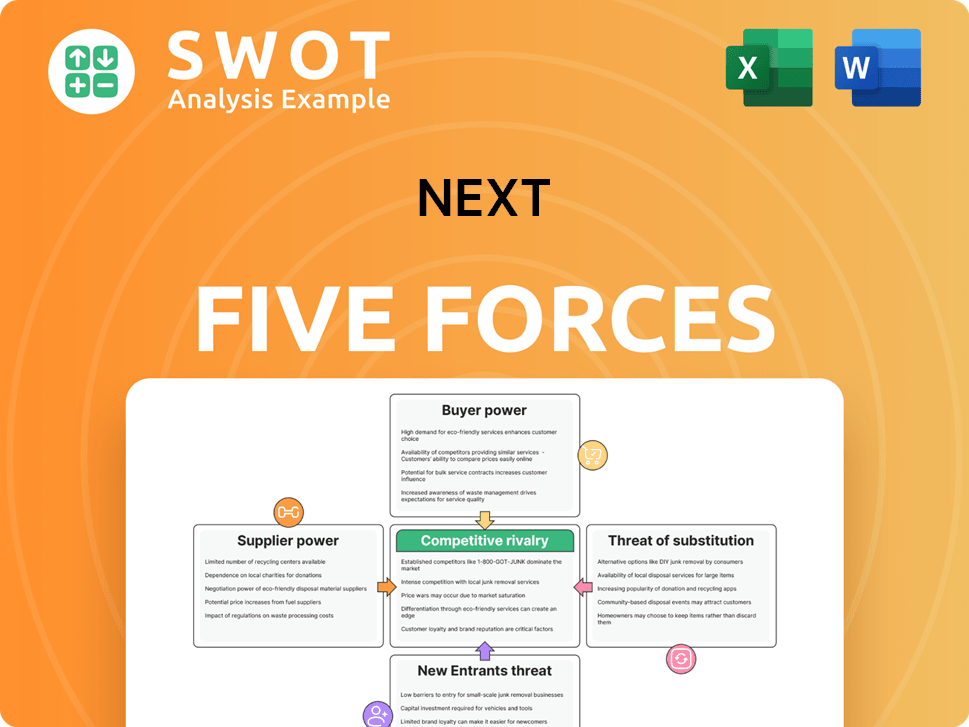
Related Blogs
- What are Mission Vision & Core Values of Next Company?
- What is Competitive Landscape of Next Company?
- How Does Next Company Work?
- What is Sales and Marketing Strategy of Next Company?
- What is Brief History of Next Company?
- Who Owns Next Company?
- What is Customer Demographics and Target Market of Next Company?
Disclaimer
All information, articles, and product details provided on this website are for general informational and educational purposes only. We do not claim any ownership over, nor do we intend to infringe upon, any trademarks, copyrights, logos, brand names, or other intellectual property mentioned or depicted on this site. Such intellectual property remains the property of its respective owners, and any references here are made solely for identification or informational purposes, without implying any affiliation, endorsement, or partnership.
We make no representations or warranties, express or implied, regarding the accuracy, completeness, or suitability of any content or products presented. Nothing on this website should be construed as legal, tax, investment, financial, medical, or other professional advice. In addition, no part of this site—including articles or product references—constitutes a solicitation, recommendation, endorsement, advertisement, or offer to buy or sell any securities, franchises, or other financial instruments, particularly in jurisdictions where such activity would be unlawful.
All content is of a general nature and may not address the specific circumstances of any individual or entity. It is not a substitute for professional advice or services. Any actions you take based on the information provided here are strictly at your own risk. You accept full responsibility for any decisions or outcomes arising from your use of this website and agree to release us from any liability in connection with your use of, or reliance upon, the content or products found herein.